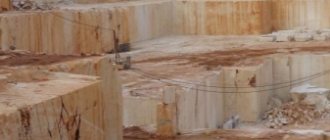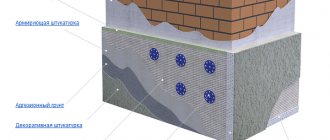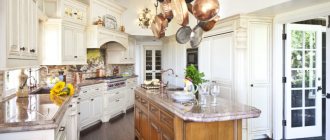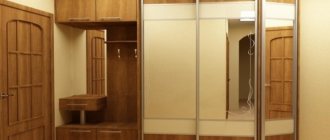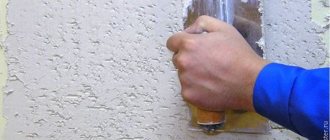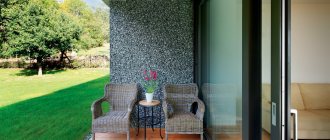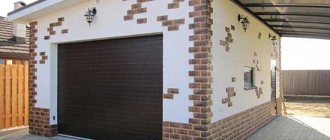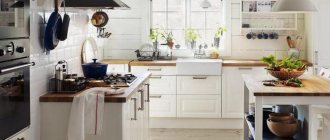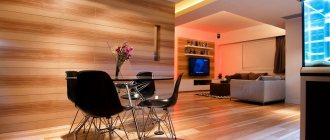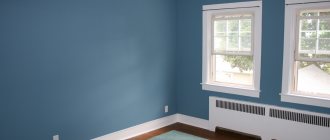Decorative plaster for the kitchen, which one to choose. What material to choose for wall decoration?
When choosing decorative finishes, special attention is paid to the following parameters:
- value for money;
- complexity of application and level of final result;
- resistance to cracking;
- the beauty of the resulting coating.
Be sure to pay attention to the type of binder. The reliability of the finishing layer, adhesion to the surface being treated, and durability depend on the base.
Below are the criteria for choosing the best decorative plaster for finishing various objects.
For the corridor
The hallway is a narrow room with little lighting. The walls become dirty more often and cracks form due to high humidity and drafts. The finishing should not only please the eye of the owner of the room, but also be practical to use.
When purchasing a mixture, it is recommended to focus on the following criteria:
- high moisture resistance so that dirt can be easily washed off with water;
- strength - the resistance of the finish to various mechanical influences will depend on its level;
- plasticity and resistance to deformation;
- requirement for the quality of the base.
Additionally, take into account the features of finishing the corridor:
- Often there is no natural light in the room, so it is better to decorate the walls in lighter colors. If you use dark colors, you should arrange the maximum amount of artificial light.
- Decorate a small hallway with materials that ultimately provide a smooth surface.
- Pay attention to the general condition of the walls. If there are small cracks, use a coarser plaster.
- If the walls are perfectly flat and smooth, then Venetian plaster will be an excellent choice. It is applied in a thin layer and completes the overall interior of the corridor.
- Treat surfaces with defects with textured or structural plaster. The composition is distributed in a thick layer, often more than one.
We invite you to look at photos of corridor design options:
For facade
When purchasing a decorative facade covering, it is important to be guided by the following parameters:
- Characteristics . High indicators of strength, moisture resistance, service life, expediency of application. For example, areas with increased contamination require the use of a dirt-repellent mixture. There is no need to select difficult-to-maintain plaster, but at the same time it must have good vapor permeability.
- Facade material. Cement-based decorative plaster is suitable for any type of wall. Silicone material is not recommended for use on external insulation. Silicate is perfect for walls made of aerated concrete or gas silicate. Brick and block surfaces are not picky about the type of plaster applied.
Attention
If the facade of the house is made of wood, then it is necessary to create two layers. The first is a cement base, the second is a decorative coating. Additionally, the mixtures must have good vapor permeability. Otherwise, moisture will accumulate between the insulation and the finishing coating, which will lead to damage to this finishing of the house.
Below are options for decorating the facade with decorative plaster:
For kitchen
The kitchen is a high-traffic area that often gets dirty. Therefore, decorative plaster should be easy to wash and not be afraid of mechanical stress and the accumulation of fat. Good options are acrylic and silicone compounds. They have the following advantages:
- resistance to high humidity, sudden changes in temperature (in the kitchen the temperature changes very often as stoves and heating equipment are turned on);
- plasticity - cracks do not form;
- easy to use - can be sold ready-made;
- attractiveness - the final result will please even the most demanding owner.
Advice
Many designers use silicate plaster, which is based on liquid glass. After treatment, the wall acquires a light glossy shine and luxurious beauty. But this is an expensive material that easily deteriorates from exposure to hot steam. Therefore, you should not overpay, but consider other options.
The relevance and practicality of decorating kitchen walls with decorative plaster
The facing coating for high-use premises must meet stringent requirements and be more reliable and durable than finishing for living rooms.
Pros and cons of using decorative coatings in the kitchen
Plaster finishing has the following advantages:
- resists moisture and high temperatures without changing its color and texture;
- easy to clean;
- — plaster does not require a perfectly smooth base and perfectly masks uneven walls;
- the ability to create different textures, patterns, colors;
- reliability and long service life.
Please note: among the disadvantages of the coating is the high cost of the material and application work.
Decorative plaster in the kitchen will give the room a special charm and color, photo
Washable plaster for the kitchen. Types of materials
Decorative plaster is not exactly the usual plaster or mortar used for leveling walls.
This is a finishing material, a special homogeneous paste, a mixture for finishing and decorating walls, ceilings, and structures. It consists of tiny grains of granite, marble or quartz chips, sand, and even pieces of algae.
Construction stores have a large selection of decorative plasters, both natural and artificial materials.
- Mineral. A dry mixture based on cement-lime mortar, marble or granite chips are added to it for relief and elasticity. This composition is durable and resistant to dampness and moisture.
- In synthetic plasters, the binding agents are polymeric materials, for example, acrylic resins, styrene, nylon fibers, liquid glass, etc. These mixtures are sold in ready-to-use formulations.
Silicone plaster (based on synthetic resin) is easy to apply, very plastic, adheres well, and is suitable for finishing external and internal surfaces.
Acrylic is easy to work with, adapts to any tool, dries quickly, is elastic and wear-resistant. Silicate is based on liquid glass, which is characterized by vapor permeability and resistance to mechanical damage. This plaster is also called universal.
Experienced craftsmen recommend choosing acrylic-based plaster for the kitchen area.
This wall covering is very practical: it is resistant to grease, is not afraid of water, does not absorb kitchen odors, and is easy to care for; you just need to wipe the wall with a damp cloth.
What is better for the kitchen: wallpaper or decorative plaster. Criteria for choosing a wall finishing method
Decorative plaster or paintable wallpaper - which is better? When answering this difficult question, you need to understand by what criteria a preliminary assessment of a particular material is carried out. The main criteria are:
- Durability of the selected coating.
- Price.
- Ease of use.
In terms of durability, wallpaper is inferior to the mixture. The prospect of re-pasting failed wallpaper is more likely than re-treating the walls with a competing composition.
Considering the pricing policy of the two materials, one must agree that wallpapers are much cheaper, although when choosing them you can encounter a high price.
For example, photo wallpaper, fabric or paintable wallpaper. The minimum price of plaster starts from 200 rubles. And the lowest cost of wallpaper does not exceed 50 rubles.
When performing repairs yourself, ease of use plays an important role. After all, it is easier to cover walls with wallpaper than to plaster the walls.
Durability
Any person carrying out repairs wants to receive a high-quality product that will be pleasing to the eye and will last a long time. For example, rare wallpaper will last about 5 years. Non-woven wallpaper will retain its beauty for 10 years. And only fiberglass materials can be used for up to 20 years. The service life of decorative mixtures is much longer than any wallpaper.
The silicone finish will provide 60 years of flawless service. Polymer will last 50 years, and mineral up to 30 years. Any decorative plaster can be washed and simply restore cracked areas.
Appearance
Expensive decorative plaster competes with other finishing materials. Experts disagree on which looks better. Rather, the choice depends on a person’s taste, the cost of the material, its qualities and service life.
Resistance to external influences
Of course, there are wallpapers that can be used in rooms with high humidity, but they need to be changed periodically. This despite the fact that the walls are pre-treated with a special compound to prevent mold.
Using decorative plaster in work areas: kitchen or bathroom, you can be sure that a high-quality finish will last up to 60 years. The appearance of mold and rotting processes is excluded.
Price
Wallpaper takes the lead in terms of affordability. The cost of plaster is several times higher than that of competing materials. Treating 1 m2 of wall with wallpaper is cheaper than working on the same area with decorative mixtures. Take, for example, treating walls with Venetian plaster. But the question of whether decorative plaster or wallpaper is cheaper should not be guided solely by price. Much depends on the service life of the material and its properties.
Decorative plaster in the kitchen: pros and cons. pros
Today, finishing kitchen walls with decorative plaster is becoming increasingly popular. There are many explanations for this; this coating has a number of advantages that have attracted attention to it for many years. The undoubted advantages of using decorative plaster include:
Decorative plaster in the kitchen
- Durability - plaster will serve well for decades. However, it is worth mentioning that such a long service life can only be achieved if the technology is fully followed and high-quality materials are used. If these conditions are met, there is no doubt that the coating will remain in excellent shape for a long time.
- Many design options - indeed, decorative plaster coating can be made in a variety of variations! And if you wish, you can create your own ornament, this will make the kitchen truly unique. The same applies to color - you can choose it from the entire color palette, based solely on your own wishes.
- The absence of seams and joints is a strong argument in favor of plaster. Surely, when gluing wallpaper, many have suffered more than once, getting rid of noticeable joints and gaps. With decorative plaster this problem will not arise - the coating will be solid and even.
- The cost is quite low, although it is worth noting that there are types that require significant costs.
- Hiding defects - if the rough wall doesn’t look very noble, don’t worry, finishing the kitchen with decorative plaster will hide everything!
- Environmental friendliness - plaster coating is considered quite environmentally friendly. Walls with this finish “breathe”, unlike walls finished with plastic.
Decorative plaster of kitchen walls - surface preparation
Decorative plaster is another way to repair kitchen walls. In order for decorative plaster to fit well and beautifully on the walls, they must be thoroughly leveled with beacon plaster or, for small unevenness, putty. If another decorative finish was previously applied, it must be completely removed and all irregularities must be cleaned.
Primer of walls
The prepared surfaces are coated with acrylic or silicone primer with deep penetration and remain in this state until completely dry (1-2 hours). If there was fresh plaster or putty on the walls, then before priming the kitchen walls you also need to make sure that the specified composition is completely dry.
Related article: Do-it-yourself putty on kitchen walls
Silk plaster in the kitchen. Types of decorative plaster for the kitchen
To understand which decorative plaster to choose for the kitchen, let’s study the composition of various types of coating:
- Natural marble or granite chips and quartz sand are added to cement-based mineral plaster, thereby creating a relief surface. Gypsum-based coating is not suitable for the kitchen. Gypsum absorbs water, swells and loses its properties.
- Acrylic contains acrylic resins at its base. This is a good choice for the kitchen. It will create a durable and strong wall covering.
- Silicate plaster with a liquid glass base is recommended for use on walls made of wood or cellular concrete due to its vapor permeability.
- Silicone plaster is plastic and suitable for application by hand. Has good adhesion to many substrates.
In appearance, plaster can be:
- Structural - depending on the size of the fractions included in it, it is divided into coarse-grained and fine-grained; When applied, large grains in the plaster form deep grooves, resulting in a “bark beetle” pattern. Bark beetle plaster in the kitchen goes well with furniture in the Provence style.
- Venetian contains marble dust and creates a smooth surface reminiscent of marble. Venetian, as one of the most expensive and beautiful coatings, belongs to the category of elite finishing and is used to create palace interiors in the baroque and classicism styles.
- Textured imitates various materials: wood, leather, concrete, crinkled fabric, etc.
- The smooth coating is suitable for different interiors. Bright kitchen furniture and textiles will balance the smooth walls in a calm color scheme. A minimalist interior with high-tech furniture will be complemented by richly colored walls.
Decorative Venetian plaster in the kitchen, photo and video materials for application
Decorative plaster in the kitchen
What can you say about the kitchen? Some people spend a lot of time there, some not so much, but everyone who lives in an apartment is there. The kitchen has its own distinctive features associated with the status of this room, and they must be taken into account when developing the design. And one of the design options could be decorative plaster in the kitchen.
General description of kitchen requirements
It is clear that the conditions in the bedroom are different from the conditions in the kitchen. High humidity and temperature are its indispensable attribute. Despite the working hood, soot and soot settle on the walls, drops of fat and evaporating moisture contribute to the general conditions in the room. Based on this, we can formulate the first requirements for materials used in the kitchen:
- resistance to high temperatures and humidity;
- resistance to significant temperature changes;
- resistance to organic substances;
- resistance to mildly aggressive environments formed when using detergents during the cleaning process;
- high mechanical strength, allowing you to wash walls with sponges and rags.
After considering purely practical issues, we can also touch on aesthetic issues. Staying indoors should be enjoyable and not cause negative emotions. And this is achieved by using warm colors and beautiful interior design when decorating the room.
Probably, many more additional requirements can be formulated, but those already stated are sufficient to draw a conclusion - as a finishing material, decorative plaster in the kitchen is the best choice. And to confirm this conclusion, let’s look at the properties of the various materials most commonly used for kitchen decoration.
Materials used to decorate the kitchen
Most often, paint, ceramic tiles and wallpaper are used to decorate the kitchen. So you can see what advantages and disadvantages each material has.
Paint in the kitchen
The choice of paint today is extremely large, and you can choose one that suits a variety of necessary requirements - for any external conditions and in any color. The advantages include an affordable price and the ability to wash painted surfaces.
Paint in the kitchen
The disadvantage is low mechanical resistance; scratches and impacts leave marks on the paint, which necessitates repainting after some time.
Ceramic tile
Resistant, mechanically strong material that can withstand strong temperature fluctuations and exposure to mildly aggressive environments. Available in a wide range of colors and various surface options.
Ceramic tiles in the kitchen
Certain disadvantages can be considered the surface in the form of a mosaic, which over time causes contamination and destruction of the grout, as well as the coldness of the material itself.
Or maybe wallpaper?
A widespread and easily implemented type of finishing, a large selection of materials, colors and patterns. Ease of use, availability and low price (for paper wallpaper).
Wallpaper in the kitchen
Disadvantages include low mechanical strength, exposure to mildly aggressive environments, and susceptibility to contamination.
About decorative plaster
Now let's try to evaluate what decorative plaster in the kitchen is in comparison with the considered alternative finishing options. That finishing material, which today is called decorative plaster, in its characteristics and capabilities is related to plaster only due to its name.
DIY kitchen plaster
True, if we are consistent in considering the properties of decorative plaster, then it should be noted that there are two types of it - synthetic and mineral. The difference is due to the type of binder used. Mineral ones use cement, lime and gypsum, while synthetic ones use polymer materials (acrylic, styrene, etc.). Another component of decorative plaster is a filler, which is chips of quartz, marble or granite. The combination of a binder and filler gives the finished mixture unique properties that allow the use of decorative plaster in the kitchen for its finishing.
Properties of decorative plaster
Since we touched on this issue, we can dwell on it in more detail. It is necessary to especially emphasize the properties of decorative plaster, regardless of its composition.
- Reliability and durability. This material does not lose its inherent properties over time. It does not collapse under the harsh conditions in which kitchen plaster is used, and retains all its advantages and benefits, including purely decorative ones, for many years.
- High mechanical strength. The coating that decorative plaster forms has increased strength, stone is stone, and the basis of such plaster is precisely stone chips. It should be noted that the mechanical strength of different fillers differs from each other, but the coating with any filler can withstand wet cleaning, which is periodically carried out in the kitchen.
- High resistance to high humidity, temperature, their sudden changes and exposure to mildly aggressive environments.
- Unique opportunities to create a wide variety of coatings, differing in color, texture and design.
About choosing decorative plaster
Probably the most difficult question will be which decorative plaster to choose. Not even that. Which kitchen design should you choose, because the possibilities of decorative plaster for creating an interior allow you to implement any. Some examples demonstrating how decorative plaster is used in the kitchen are shown in the photos below:
Decorative plaster in the kitchen, photo of the relief surface
Decorative coating, Venetian plaster (antique)
There are many more existing possibilities that decorative plaster allows you to implement, and you can consider some specific options for decorating a kitchen using different types and techniques for applying decorative plaster.
Relief plaster
In the process of applying the finishing coating, for which decorative plaster is used, a pattern is created on the surface with a spatula, trowel, roller or, ultimately, with your hands. There are many ways to create such designs; any color of the coating can be chosen, and the resulting result will be original. An example of such coverage can be seen below:
Relief plaster
Read more in the article: DIY relief plaster
Plaster "Bark beetle"
Another, no less interesting option for decorating the kitchen interior would be finishing it with “Bark Beetle” plaster. It uses marble or granite chips as a filler. The technology for creating the coating involves leveling the surface after application, as a result of which the mineral chips, rolling over the wall, leave a pattern reminiscent of the passages of a bark beetle in wood.
The resulting surface has an original appearance and can be additionally painted in any color. An example of decorating a wall with similar plaster can be seen in the photo below:
Decorative plaster "Bark beetle"
Venetian plaster
One of the most common coatings is Venetian plaster. It is used to create high-quality, one might say, elite coating in a wide variety of rooms.
This coating is a mixture of marble flour (dust) with polymer resin (acrylic). As a result of proper application, the result is a surface reminiscent of marble, which appears transparent in the rays of light and evokes an indescribable play of it. And although it is impossible to convey it in a photo, you can still see what Venetian plaster looks like in the kitchen below.
Venetian plaster in the kitchen
However, when choosing this method of finishing a kitchen, for all its attractiveness and unique appearance, it is necessary to take into account that the effect of plaster is due to a special technique for applying decorative coating. Venetian plaster cannot be purchased, it can only be created by application. To do this, you have to apply at least three layers of plaster, and each one needs to be worked on for a long time and carefully.
The labor intensity of applying such a coating is high, and therefore the cost of performing the work is quite significant. However, if you are willing to put in the time and take on the task of applying Venetian plaster yourself, then this is a completely doable task after proper preparation.
Decorative plaster on the apron. Food for thought
It is clear that the decoration in the kitchen should be different from that, for example, in the bedroom or living room. It must meet the following requirements:
- do not absorb odors and moisture;
- easy to clean without damaging the finishing layer;
- be resistant to high temperatures
It is recommended to rely on smooth glossy coatings. Everything is simple here: the less rough the surface, the lower the likelihood that dirt will stick to it and mold will develop. Smooth surfaces are easier to clean. For this reason, the final stage of finishing is the application of a protective layer of wax, glaze enamel or varnish.
We will leave questions regarding the design part at your discretion, but we still advise you to avoid overly pretentious solutions. the video as an example
In the video below, we would like to warn many property owners. Be careful when choosing texture and color scheme! Many of them will look redundant and out of place in the kitchen. At first glance this will seem original and beautiful. Over time, such walls will begin to put pressure on you and visually reduce the volume of the kitchen.
It is better to finish the wall around the perimeter of the work area near the sink and stove (apron) with a more resistant material, for example, tiles or tempered glass. Of course, if you do not want to make repairs every time the decorative plaster coating becomes seriously dirty. On all other walls such compositions can be used without any restrictions. Solutions that combine decorative plaster coatings with wood finishing, well-chosen wallpaper and, of course, furniture materials look good.
If you seriously intend to use such a finish, then regardless of the type of coating, it is important to properly prepare the walls for applying decorative plaster. Now let’s figure out what the appearance of our kitchen will be.
The video below shows, at first glance, a good option for finishing a kitchen with decorative plaster. But if you take a closer look, you notice poor quality work on the corners, as well as an overly bold approach to finishing the work area. Aprons made of such plaster are an impractical and short-lived solution.
Finishing kitchen walls with plaster
Decorative plaster in the kitchen creates a unique atmosphere, combining the coolness of stone and the calm reliability of the walls in an aesthetic design. Furniture of almost any style fits into this design. The color scheme in which the kitchen will be finished is selected individually during the preparation of finishing mixtures with the addition of a measured amount of color. The texture of the coating pattern can be made in one ensemble with furniture and other accessories. Not only vertical planes are artistically plastered, but also the ceiling, columns, openings, and niches.
